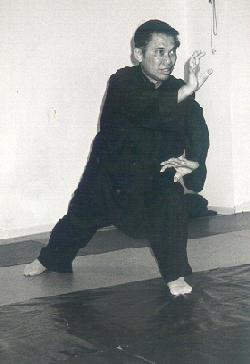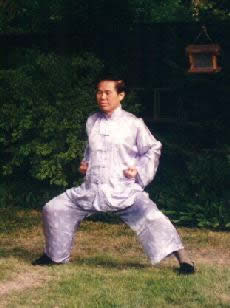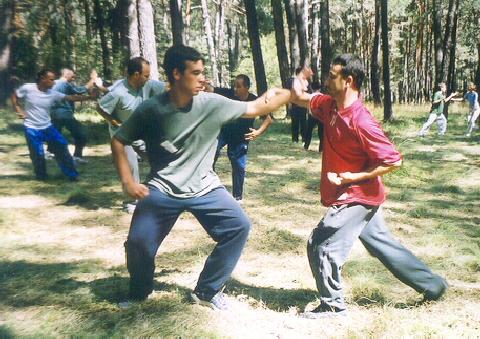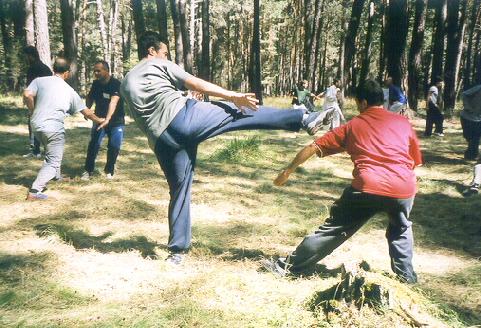January 2004 (Part 2)
SELECTION OF QUESTIONS AND ANSWERS

An old photograph of Sifu Wong demonstrating the Shaolin pattern “Hungry Tiger Catches Goat”. Correct body position and footwork are crucial in this “double tiger-claws” pattern, otherwise it would not be effective.
Question 1
I would like to thank you for giving the extra attention to me and my brother at the London Chi Kung course in May. I shouldn't write to you until I have got a real breakthrough in my Shaolin training, but I have some questions about my progress which I would like to ask you.
— Kan, Holland
Answer
I am glad to hear from you. Honestly, I was quite concerned when I first saw your condition when we first met, but now reading your e-mail which is well written clearly and coherently, I feel relieved, knowing that you actually have made a breakthrough, though you yourself may not be aware of it.
This, indeed, is an invaluable benefit of chi kung and kungfu training that many people, including myself in my early days, may not realize. Our progress is so gradual, which is good, that we are usually not aware of it until we compare our present condition with that when we first started training. Anthony gave an excellent explanation of this point in the Shaolin Wahnam Discussion Forum at http://www.wongkiewkit.com/forum/showthread.php?s=&threadid=1140.
You are welcome to write to me whenever you have questions. Alternatively, you can ask questions in our Shaolin Wahnam Discussion Forum when one or more of our Shaolin Wahnam instructors will answer them. You may also like to share your experiences or benefits with others in the forum.
Question 2
I understand that if there is some pressure on someone's forehead during standing meditation it could be the “third eye” opening or a blockage. But, is it normal that this pressure is present when I'm doing stance training? I got this pressure since May. I try to ignore it though.
Answer
Yes, it is normal for any chi effect to be felt at other times too. In your case it is normal to feel the pressure at your forehead during your stance training. When you sits at your stance, you may he relaxed or tensed. In either case, the pressure at the forehead may be increased.
How is it possible that two opposing situations bring about similar effects? Asking such a question is an example of dualistic thinking, which is quite common in Western culture. When you are relaxed, you increase your chi flow, which will add pressure to your forehead. When you are tensed, you aggravate the blockage, which will also increase the pressure.
You are right not to think of or worry about this pressure, which is another but better way of saying to ignore it. However, if the pressure becomes acute, you should complete your stance training and go into chi flow. Gently think of the site of the pressure to direct chi there to break-through or at least “loosen” the blockage. If the pressure becomes very painful, slow down or even stop your chi kung practice, including stance training, for a few days.

In the Horse-Riding Stance the feet are about two and a half to three shoulder's widths apart. Relax totally and attain a state of non-thought.
Question 3
When interrupting thoughts enter my mind and I'm trying to “smile from my heart” against it, I feel like I have just abruptly stopped a rush of chi in my head which makes me a bit uncomfortable.
Answer
Dan's explanation of “non-thought” and “no-thought” in our Shaolin Discussion Forum on mind training at http://www.wongkiewkit.com/forum/showthread.php?s=&threadid=1006&perpage=10&pagenumber=2 will be very helpful in identifying and then overcoming your problem.
What you did was using thoughts to stop thoughts. This resulted in blocking a flow of chi that you had generated in your chi kung training, and was uncomfortable or might bring about a headarche. If this is done intensely or for a long time, it brings harmful effect. Many people suffer from such a harmful effect without knowing it.
A related problem is to build up thoughts upon thoughts. This problem is pervasive in Western culture, especially amongst intellectuals. Ironically, such people when they cram too many thoughts into their heads, become dull and often depressed.
So, what should you, and these people, do? Actually it is very simple, but may not be easy for most people. Aim for non-thought, which is different from no-thought. In practical terms, do not think of anything. Just let you chi flow. Do not attempt to smile from your heart. Just smile from your heart. Do not smile from your heart to stop your train of thoughts. Just smile from your heart.
For those who have not been trained in such skills described above, those instructions are just hollow words. They have no difficulty with the dictionary meaning of the words, but they do not really know what the words mean. For example, they do not really know what actually is “Just let your chi flow” or “Just smile from your heart”. This is one of many reasons why unless he is already an expert, one cannot get the best benefits of an art by learning from a book or a video.
But you will have no difficulty to following these instructions because you have been trained to do so in my chi kung class. You may not be able to perform these instructions as skillfully as your seniors, or you may not even be able to perform these instructions well. But the important point is that you are able to perform these instructions. With time and practice, you will be able to do them well — letting your chi flow and smiling from your heart.
The following philosophical point will be illuminating and help to clear some mental blockage. Consciously or subconsciously, many people are afraid to let go of all thoughts. They reason, mistakenly, that if they have no thoughts they may become a moron. In many ways, this is a linguistic or cultural problem brought about by the Western concept of “the supremacy of the intellect”. It is also a manifestation of dualistic thinking, resulting in a failure to realize that purposefully choosing not to think is very different from not being able to think.
The ability to think well is enhanced when the mind is clear. Have you ever wondered what is actually meant when we say “the mind is clear”? It means the mind is cleared of all thoughts. When the mind has been cleared of all thoughts, we bring forth the one thought in question and focus on it. This is attaining a one-pointed mind, which means the mind is cleared of all irrelevant thoughts.
How do you attain a clear mind or a one-pointed mind? We do this all the time in our chi kung or kungfu training! For example, before you perform “Lifting the Sky” or the Horse-Riding Stance, you stand upright, relax, clear your mind of all thoughts and smile from your heart. Then as you perform the chi kung exercise or stance, you gently focus on your breathing. This is mind training — aiming at non-thought or a one-pointed mind. For us, it is not a question of how to do it, but a question of how well or badly we do it.
Question 4
Despite practicing Chi Kung everyday since May, I still have trouble getting up early every morning. Because of my new schedule of school I have to get up at 07:00 five days a week. If I get up half an hour earlier to practice Chi Kung, I will be clumsier the whole day than when I don't do it and sleep half an hour more.
Also, I will almost fall asleep when I practice stances at night. So, is it alright if I skip the dynamic Chi Kung in the morning, but still practice stance training at night?
Answer
Your problem is mental fatigue, due to mental blockage brought about by too much thinking or worrying. Your solution is not to add energy by stance training but clear blockage by energy flow.
In practical terms, stop your stance and other kungfu training for some time, and just practice your dynamic chi kung patterns like “Lifting the Sky” and “Carrying the Moon”, as well as Self-Manifested Chi Movement. The emphasis is on cleansing, not building.
It is a common misconception held by many chi kung students that they progress by adding more energy to themselves. This is often not true. In chi kung training, especially at the earlier stages, cleansing is more important than building. If you have much blockage — which may not necessarily be physical, but can be emotional, mental or spiritual — adding more energy is likely to aggravate your problem.
This is probably your case. Chi kung and kungfu training, when performed correctly, should make you fresh and energized. If you feel dull or tired, you have over-practiced or have practiced wrongly. Or you may have practiced correctly but your life-style is so bad, including constantly worrying or excessive intellectualizing, that the negative effects of bad life-style overwhelm the good effects of correct training. It is also likely that you are tensed in your stance training, thus aggravating your blockage.
You may worry that by stopping your stance and other kungfu training, you may retrogress in your kungfu development. Such worrying is unfounded. Your present stance training is not only not bringing you benefits, it is causing you harm. Feeling sleepy is Nature's way of warning you that your kungfu training is wrong or excessive, and telling you to slow down or stop.
After you have cleared your blockage with your chi kung exercises, you can resume your stance and other kungfu training. You will progress faster and more this way. This is a manifestation of the saying “start later but arrive earlier”.

A sparring practice during a regional Shaolin Kungfu class in San Leonardo, Spain in August 2003. The exponent on the left has just retreated his front left leg as he deflects an attack from his opponent. This footwork adjustment which is a part of footwork training is important, not only for neutralizing the impact of the attack but also for preparing a subsequent kick. Had he not made this footwork adjustment, kicking with his left leg would be too far from target, and kicking with his right leg would be too near.
Question 5
Thank you very very much for returning me to happiness. For many years I only did “water buffalo training” and I always had low energy the whole day. Then I found by chance your website. Then I read your book, “The Art of Shaolin Kung Fu" and since then I do stance training, flexibility exercises and standing meditation, as you described in your book. Now I feel a lot of energy every day from morning to night.
— Ronny, Switzerland
Answer
I am very glad of your benefits and progress. The exercises look simple, and are simple, but they are also very profound. Many people had told me they were amazed that such simple exercises could bring them so much benefit.
You have probably performed the exercises correctly, but I would still like to remind you that you must be relaxed when performing the exercises, especially stance training. It is an interesting paradox that the more you relax, the more energy you will develop — a fact most people find hard to believe. But for those who understand chi kung philosophy, it is no surprise at all.
You can now progress to the next stage, if you have not done so already. After your stance training or flexibility exercises, bring your feet together to stand upright, and then just let go. Do not think of anything, and do not do anything. Soon you may find your body swaying. Don't tense your muscles to stop the sway. Just follow the swaying movements. You will find that you sway “involuntarily”.
This is what we call a chi flow. It is both very beneficial and pleasant. Your outward bodily movements are the result of your internal energy flow. However, if your movements become vigorous, slow down the movements. You can do so by gently telling your body to slow down. Your body will follow your mind's instruction if you do so gently but firmly.
Question 6
How wide apart must the legs be in a correct Horse-Riding Stance? In the Questions and Answers Series, March 2000 Part 3, I saw a picture of you doing the Horse-Riding Stance. Before this I did the Horse-Riding Stance with the feet closer together, as shown by a kungfu film star on his website.
Your legs (in the Horse-Riding Stance) are wider apart. So, when I saw this picture, I changed my Horse-Riding Stance and now I stay wider apart. I must say, I feel more chi in this way. I am sure you are right, but I just want to make sure.
Answer
In a Horse-Riding Stance, the feet should be about two and a half to three shoulder's widths apart, like what I show in the photograph. If the feet are too close, like what the film star shows, it may cause energy blockage at the legs, hips or back.
The feet should be parallel to each other and the knees extended out. In some of the photographs showing me at the Horse-riding Stance, the feet appear to point outward. This is incorrect, and the apparent pointing outward is due to an optical illusion of these photographs, and not what is actually performed by me.

To defend against the opponent's kick, the exponent on the right merely shifts his body backward without having to move his feet. This shifting of his body is an aspect of “body” training, and here it gives him a technical advantage. His counter-attack, for example, would be faster, often before the opponent could withdraw his kicking leg. Had the exponent bounced away, as many untrained persons may do, he would not only lose this advantage but also interrupt his own momentum as well as his smooth breathing — combat factors that many people may not be aware but may be crucial in high level fighting.
Question 7
Is the Horse-Riding Stance the same as “Ma Bu” in Chinese?
Answer
Strictly speaking the answer is no, although some kungfu practitioners use the terms “ma bu” to refer to the Horse-Riding Stance, “gong bu” to refer to the Bow-Arrow Stance, and “xu bu” to refer to the False Leg Stance. In Chinese the Horse-Riding Stance is called “si peng da ma” (“seai peng tai ma” in Cantonese). Often it is shortened to “si peng ma”.
“Ma bu” means “stance-footwork”. It refers to two aspects of kungfu training, namely stance training and footwork training. Stance training and footwork training are fundamental in kungfu, but today most students neglect them. They complement each other. Amongst other benefits, stance training develops solidness, whereas footwork training develops flexibility. If one is solid but lacks flexibility, or is agile but lacks solidness, his training is incomplete.
Besides the Horse-riding Stance, which is the most important, other stances are also practiced, like the Bow-Arrow Stance, the False Leg Stance, the Single Leg Stance, the Goat Stance and the Unicorn Stance.
The Unicorn Stance is often called the Unicorn Step. The basic difference between a stance and a step is that the former is relatively stationary whereas the latter is relatively mobile.
In our Shaolin Wahnam school, we learn various “steps” in our footwork training, such as the up-step, the down-step, the drag-step, the flow-step and the arrow-step in one, two, three or more moves, via the inner or the outer approach, and using the left or the right mode. By varying these steps in different combinations we can create numerous advantages in our attack or defence.
Many kungfu practitioners have heard of the term “six harmonies”, or “liu he” (“lok hap” in Cantonese pronunciation) in Chinese, but may not know what they mean. The “six harmonies” refer to the harmonies of jing, qi, shen (pronounced in the second tone), shen (pronounced in the first tone), shou, bu, which are “essence”, “energy”, “mind”, “body”, “hand” and “footwork”.
The first three factors -- “essence”, “energy” and “mind” -- are internal; and the latter three -- “body”, “technique" and “footwork” -- are external. To be a good kungfu practitioner, one must be harmonious in all the six factors. Even when your technique is correct, but if your footwork or body position is out, for example, you will not be effective in your combat application. Even when your kungfu performance is magnificent, but if you are lacking in “essence” or “energy”, you may not gain much benefit.
The term jing, translated as “essence” here, is elusive or encompassing in Chinese. It may refer to different meanings in different context. Using the Horse-riding Stance as an example, the harmony of jing, qi, shen, and shen, shou, bu at the most basic level means that you are relaxed, your chi is flowing, your mind is clear, your body is upright, your fists are firmly held at your waist, and your feet are about two and a half to three shoulder's widths apart.
It is a pity that today the standard of kungfu has been debased so badly that most practitioners, including most instructors, are unaware of these six harmonies. Not only they have no idea of “essence”, “energy”, “mind”, and “footwork”, often they are also ignorant of “body harmony” and “hand harmony”, the two most obvious of the six harmonies. It is not uncommon today to see even “masters” displaying poor balance due to poor body position, and holding their fist at a distorted angle so that if their punch connects they might dislocate their own wrist!
Question 8
I have heard much about the health risks of the Nei Dan (Mental) aspect of Chi Kung. I have read your book "The Art of Chi Kung: Making the Most of Your Vital Energy" and find it an excellent read. However you do not mention any such risks. Could you please explain any dangers associated with Chi kung practice and any health risks that could develop through training wrongly. Thus far I am only at the beginning of my chi kung path, practising “Lifting the Sky“ ten times daily.
— Lambro, USA
Answer
“Nei Dan” means “internal elixir”. “Elixir” refers to a crystallized pearl of vital energy. Nei Dan Chi Kung is a special type of chi kung where practitioners develop this pearl of elixir at their “dan tian” or elixir field, usually located about two or three inches below their naval. But they may also locate the “dan tian” at other places, such as the crown of the head, the third eye, or the solar plexus. Visualization and other mental skills are usually required in Nei Dan Chi Kung.
I have always emphasized that advanced chi kung, like Nei Dan Chi Kung where profound visualization is involved, should be attempted under the supervision of a master or at least a competent instructor. If practiced incorrectly, it can lead to serious harmful effects.
These harmful effects are many and varied, but may be classified into three major categories, namely physical, energetic and spiritual (which includes the mental and the emotional). The classification is for convenience; there is usually much over-lapping.
Some examples of physical harmful effects are chronic pain, physical deformities and structural defects of internal organs like peptic ulcers and faulty heart valves. Some examples of energetic harmful effects are allergies, malfunction of internal organs or systems like hypertension and diabetes, and weakening of the immune system resulting in infectious diseases. Some examples of spiritual harmful effects are anxiety, depression, aggression, memory loss, feeling of hopelessness, and perverted views.
The harm is often insidious, i.e. it is not easy to relate the harm to the wrong practice. For example, while employing visualization to build a pearl of elixir, a practitioner may accidentally cause some energy blockage, which may be translated into Western terms as hardening a nerve with the result that mental impulses could not flow effectively. If this nerve is connected with the pancreas, it may cause diabetes. If it is connected with the liver, which controls the blood, it may weaken his blood system that may result in him succumbing to a viral infection that in his normal condition he could have overcome without his conscious knowing.
Nevertheless, while the risks and dangers of wrong training are real, one should not worry unnecessarily so long as he follows instructions respectfully. Practicing chi kung is safer than walking down a busy street. But if he stubbornly goes against the instructions, like purposely tensing his muscles when he is supposed to be relaxed, he is asking for trouble.
The more advanced the chi kung exercise is, the more harmful will be the wrong practice. Chi kung which operates at the mind level is generally more advanced than that which operates on the energy level, which in turn is more advanced than that which operates on the physical level. Hence, mainly for safety reasons, chi kung taught en mass to the public usually operates on the physical level. i.e. practitioners perform a lot of forms with little or no attention to breathing and visualization.
“Lifting the Sky” is a wonderful exercise. It can be operated at any level. If you follow the instructions explained in my books, and leave out the breathing aspects and the visualization, you are fairly safe even if you accidentally make some mistakes in your practice. I would recommend that you perform “Lifting the Sky” about 20 to 30 times instead of just 10 times. (Note: this is a general recommendation for most people, especially those who learn from my books. Others, like those who have learnt from me personally, may perform less times for maximum result.) You should be relaxed and you should not be thinking of anything when performing the exercise. You should experience good results after practicing daily for six months.
LINKS
Selected Reading
- Bullshit in Chinese Martial Art? — Grandmaster Kai Uwe Jettkandt
- Taijiquan Striking Hands Series 2 — Seeking Advantages for Striking Attacks
- Taijiquan Defence Against Fundamental Attacks
- A Comparison of Shaolin Kungfu and Taijiquan
- Seeing Things Clearly and in a Completely Different Way
